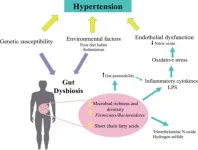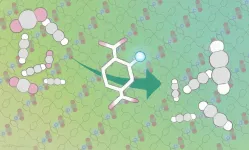(Press-News.org) A study of Japanese university students and recent graduates has revealed that writing on physical paper can lead to more brain activity when remembering the information an hour later. Researchers say that the unique, complex, spatial and tactile information associated with writing by hand on physical paper is likely what leads to improved memory.
"Actually, paper is more advanced and useful compared to electronic documents because paper contains more one-of-a-kind information for stronger memory recall," said Professor Kuniyoshi L. Sakai, a neuroscientist at the University of Tokyo and corresponding author of the research recently published in Frontiers in Behavioral Neuroscience. The research was completed with collaborators from the NTT Data Institute of Management Consulting.
Contrary to the popular belief that digital tools increase efficiency, volunteers who used paper completed the note-taking task about 25% faster than those who used digital tablets or smartphones.
Although volunteers wrote by hand both with pen and paper or stylus and digital tablet, researchers say paper notebooks contain more complex spatial information than digital paper. Physical paper allows for tangible permanence, irregular strokes, and uneven shape, like folded corners. In contrast, digital paper is uniform, has no fixed position when scrolling, and disappears when you close the app.
"Our take-home message is to use paper notebooks for information we need to learn or memorize," said Sakai.
In the study, a total of 48 volunteers read a fictional conversation between characters discussing their plans for two months in the near future, including 14 different class times, assignment due dates and personal appointments. Researchers performed pre-test analyses to ensure that the volunteers, all 18-29 years old and recruited from university campuses or NTT offices, were equally sorted into three groups based on memory skills, personal preference for digital or analog methods, gender, age and other aspects.
Volunteers then recorded the fictional schedule using a paper datebook and pen, a calendar app on a digital tablet and a stylus, or a calendar app on a large smartphone and a touch-screen keyboard. There was no time limit and volunteers were asked to record the fictional events in the same way as they would for their real-life schedules, without spending extra time to memorize the schedule.
After one hour, including a break and an interference task to distract them from thinking about the calendar, volunteers answered a range of simple (When is the assignment due?) and complex (Which is the earlier due date for the assignments?) multiple choice questions to test their memory of the schedule. While they completed the test, volunteers were inside a magnetic resonance imaging (MRI) scanner, which measures blood flow around the brain. This is a technique called functional MRI (fMRI), and increased blood flow observed in a specific region of the brain is a sign of increased neuronal activity in that area.
Participants who used a paper datebook filled in the calendar within about 11 minutes. Tablet users took 14 minutes and smartphone users took about 16 minutes. Volunteers who used analog methods in their personal life were just as slow at using the devices as volunteers who regularly use digital tools, so researchers are confident that the difference in speed was related to memorization or associated encoding in the brain, not just differences in the habitual use of the tools.
Volunteers who used analog methods scored better than other volunteers only on simple test questions. However, researchers say that the brain activation data revealed significant differences.
Volunteers who used paper had more brain activity in areas associated with language, imaginary visualization, and in the hippocampus -- an area known to be important for memory and navigation. Researchers say that the activation of the hippocampus indicates that analog methods contain richer spatial details that can be recalled and navigated in the mind's eye.
"Digital tools have uniform scrolling up and down and standardized arrangement of text and picture size, like on a webpage. But if you remember a physical textbook printed on paper, you can close your eyes and visualize the photo one-third of the way down on the left-side page, as well as the notes you added in the bottom margin," Sakai explained.
Researchers say that personalizing digital documents by highlighting, underlining, circling, drawing arrows, handwriting color-coded notes in the margins, adding virtual sticky notes, or other types of unique mark-ups can mimic analog-style spatial enrichment that may enhance memory.
Although they have no data from younger volunteers, researchers suspect that the difference in brain activation between analog and digital methods is likely to be stronger in younger people.
"High school students' brains are still developing and are so much more sensitive than adult brains," said Sakai.
Although the current research focused on learning and memorization, the researchers encourage using paper for creative pursuits as well.
"It is reasonable that one's creativity will likely become more fruitful if prior knowledge is stored with stronger learning and more precisely retrieved from memory. For art, composing music, or other creative works, I would emphasize the use of paper instead of digital methods," said Sakai.
INFORMATION:
This research is a peer-reviewed, experimental study on people published in Frontiers in Behavioral Neuroscience. Funding was provided by the Consortium for Applied Neuroscience at NTT Data Institute of Management Consulting, Inc. The funder was not involved in the study design, collection, analysis, interpretation of data, the writing of the research paper, or the decision to submit it for publication.
Research Publication
Keita Umejima, Takuya Ibaraki, Takahiro Yamazaki, and Kuniyoshi L. Sakai. 19 March 2021. Paper Notebooks vs. Mobile Devices: Brain Activation Differences During Memory Retrieval. Frontiers in Behavioral Neuroscience. DOI: 10.3389/fnbeh.2021.634158
Related Links
Sakai lab: https://www.sakai-lab.jp/english/
Graduate School of Arts and Sciences: https://www.c.u-tokyo.ac.jp/eng_site/
Research Contact
Professor Kuniyoshi L. Sakai
Department of Basic Science, Graduate School of Arts and Sciences,
The University of Tokyo,
3-8-1 Komaba, Meguro-ku, Tokyo 153-8902, JAPAN
Tel: +81-03-5454-6261
Email: kuni@sakai-lab.jp
Press Officer Contact
Ms. Caitlin Devor
Division for Strategic Public Relations,
The University of Tokyo,
7-3-1 Hongo, Bunkyo-ku, Tokyo 133-8654, JAPAN
Tel: +81-080-9707-8178
Email: press-releases.adm@gs.mail.u-tokyo.ac.jp
About the University of Tokyo
The University of Tokyo is Japan's leading university and one of the world's top research universities. The vast research output of some 6,000 researchers is published in the world's top journals across the arts and sciences. Our vibrant student body of around 15,000 undergraduate and 15,000 graduate students includes over 4,000 international students. Find out more at http://www.u-tokyo.ac.jp/en/ or follow us on Twitter at @UTokyo_News_en.
Funders
Consortium for Applied Neuroscience, NTT Data Institute of Management Consulting, Inc.
Philadelphia, March 19, 2021 - In recent years, fermented dairy foods have been gaining attention for their health benefits, and a new review published in the Journal of Dairy Science indicates these foods could help reduce conditions like hypertension (high blood pressure). A team of investigators from the Center for Food Research and Development in Sonora, Mexico, and the National Technological Institute of Mexico in Veracruz reports on numerous studies of fermented milks as antihypertensive treatments and in relation to gut microbiota modulation. They also examine the potential mechanistic pathways of gut modulation through antihypertensive fermented milks.
In addition to the impact of genetics and the environment, there is growing ...
During the first six months of the pandemic, as people attempted to stay away from hospitals caring for those sick with COVID-19, potentially avoidable hospitalizations for non-COVID-19-related conditions fell far more among white patients than Black patients, according to a new study that looked at admissions to UCLA Health hospitals.
The findings indicate that the COVID-19 crisis has exacerbated existing racial health care disparities and suggest that during the pandemic, African Americans may have had worse access than whites to outpatient care that could have helped prevent deterioration of their non-COVID-19 health conditions, said Dr. ...
LA JOLLA, CALIF. - March 19, 2021 - Scientists at Sanford Burnham Prebys Medical Discovery Institute have identified a drug candidate that blocks the uptake of glutamine, a key food source for many tumors, and slows the growth of melanoma. The drug is a small molecule that targets a glutamine transporter, SLC1A5, which pumps the nutrient into cancer cells--offering a promising new approach for treating melanoma and other cancers. The study was published in the journal Molecular Cancer Therapeutics.
"While great strides have been made recently in the treatment of melanoma, many patients' tumors become resistant to therapy, and this has become a major obstacle in the successful treatment of the disease," says Ze'ev ...
A more energy-efficient method improves how an industrial gas is purified by reversing the traditional process. The concept was developed and successfully tested by scientists at Kyoto University's Institute for Integrated Cell-Material Sciences (iCeMS) in Japan and colleagues. The findings were reported in the journal Angewandte Chemie International Edition.
Acetylene is a gas used in many industries, including as a fuel in welding and a chemical building block for materials like plastics, paints, glass and resins. To produce acetylene, it first needs to be purified from carbon dioxide. Traditionally, this is done by passing the acetylene/carbon ...
Colorectal cancer survivors who maintained a stable body weight but lost muscle and developed fatty deposits in their muscles faced a 40 percent higher risk of premature death than patients who avoided both health issues.
"The conventional wisdom has been that colorectal cancer patients should avoid losing or gaining weight during treatment," said Dr. Justin C. Brown, Assistant Professor and Director of the Cancer Metabolism Program at Pennington Biomedical Research Center. "But maintaining your weight does not mean your body composition remains the same. Muscle can ...
COVID-19 vaccines being rolled out in the UK are effective in preventing severe disease, but the extent to which they prevent against infection is still unclear.
First modelling study looking at relaxing control measures (eg, mask wearing, physical distancing, and lockdown measures) and planned vaccination rollout in the UK suggests that vaccination alone may not be enough to prevent the spread of infection - with the R number estimated to be 1.58 even if the vaccine prevents 85% of new infections occurring, after vaccine rollout is complete and all other control measures are removed.
Relaxing control measures is highly likely to lead to another wave of infection, ...
Reporting in the Lancet Psychiatry today, psychologists at the University of Bath highlight that a widely used technique for autism screening is being misused, which may have prevented many people from receiving an autism diagnosis over the past decade.
When individuals with suspected autism are assessed by a GP, a decision to refer them to a specialist for diagnosis is informed by using the Autism Spectrum Quotient. This ten-point scale, known as the 'AQ-10', is an internationally used technique, whereby individuals agree or disagree with statements such as 'I find it difficult to work out people's intentions'. ...
URBANA, Ill. - Opioid use has dramatically increased in the 21st century, especially among young adults. A new study from the University of Illinois provides insights on usage patterns among Illinois high school students to help inform prevention and treatment strategies.
"The societal and personal costs of opioid misuse are massive. There's been a lot of focus on trying to understand how to combat the current epidemic. But we also need to make sure we have good data in order to know how we should apply our efforts," says Allen Barton, assistant professor in the Department of Human Development and Family Studies at U of I and lead author on the study.
The researchers based their study ...
Using molecular dating tools and epidemiological simulations, researchers at University of California San Diego School of Medicine, with colleagues at the University of Arizona and Illumina, Inc., estimate that the SARS-CoV-2 virus was likely circulating undetected for at most two months before the first human cases of COVID-19 were described in Wuhan, China in late-December 2019.
Writing in the March 18, 2021 online issue of Science, they also note that their simulations suggest that the mutating virus dies out naturally more than three-quarters of the time without causing an epidemic.
"Our study was designed to answer the question of how long could SARS-CoV-2 have circulated in China before it was discovered," said senior author Joel O. Wertheim, PhD, associate professor in the ...
PROVIDENCE, R.I. [Brown University] -- In 2018, physicists showed that something interesting happens when two sheets of the nanomaterial graphene are placed on top of each other. When one layer is rotated to a "magic angle" of around 1.1 degrees with respect to the other, the system becomes a superconductor -- meaning it conducts electricity with zero resistance. Even more exciting, there was evidence that it was an unconventional form of superconductivity -- a type that can happen at temperatures well above absolute zero, where most superconducting materials function.
Since the initial discovery, researchers have been working to understand this exotic state of matter. Now, a research ...






